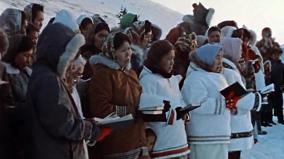Unitas Fratrum: The Moravians in Labrador
The Moravians, an early Protestant group, founded missions on the Labrador coast in the 18th century. Serving as a buffer between the Indigenous people and the whalers, the Moravians laid the basis for a new society that blended traditional European and Inuit cultures. This film shows a year in the life of the Moravian mission of Nain and describes some of the stresses the modern world has brought to this isolated Arctic community. Interviewed are a retired teacher who came with the last European mission, and the first Native Moravian minister. (Telecast in the Man Alive series under the title …

Details
-
directorHubert Schuurman
-
photographyHubert Schuurman
-
producerRex Tasker
-
executive producerBarry Cowling
-
scriptAmanda McConnellHubert Schuurman
-
soundHerb BrownArthur Irwin
-
editingHubert SchuurmanRex Tasker
-
sound editingSean Whalen
-
hostRoy Bonisteel
Education
Pedagogical evaluations and study guides are only available to CAMPUS subscribers.
CAMPUS
Features designed specifically for teachers. Learn more
Already subscribed? Sign in











